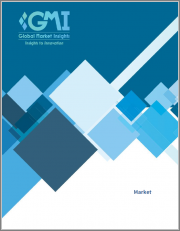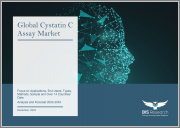
|
시장보고서
상품코드
1411270
시스타틴 C 측정 시장 : 제품 유형별, 시료 유형별, 측정 방법별, 용도별, 최종 용도별(2024-2032년 예측)Cystatin C Assay Market - By Product (Kits, Reagents, Analyzers), By Sample Type (Blood, Urine), By Method (ELISA, PETIA, PENIA, CLIA, Immunofluorescence Assay), By Application, End use & Forecast, 2024-2032 |
||||||
시스타틴 C 측정 산업 규모는 2024년부터 2032년까지 연평균 복합 성장률(CAGR)7.7% 이상으로 확대될 것으로 예측 만성 신장 질환(CKD)의 전 세계 유병률 증가와 고령화가 결합하여 시스타틴 C 측정과 같은 정확하고 조기 진단 도구에 대한 수요가 증가하고 있습니다.
최근 몇 년동안 크레아티닌과 같은 전통적인 바이오마커는 신장 기능 장애를 조기에 감지하는 데 한계가 있다는 인식이 높아지고 있습니다. 기술의 발전으로 보다 민감하고 특이적인 분석법이 개발되고 있습니다. 예를 들어, 2022년 8월 스위스의 MedTech 기업 Bloom Diagnostics는 전혈 내 시스타틴 C를 정량화하기 위해 설계된 Bloom Kidney Test를 출시했습니다. 예방 의료의 중요성이 높아지고 혁신적인 진단 솔루션이 의료 시스템에 통합되는 것도 시장 확대에 박차를 가할 것으로 보입니다.
시스타틴 C 측정 시장은 제품, 샘플 유형, 측정 방법, 용도, 최종 용도 및 지역으로 분류됩니다.
제품별로는 만성 신장 질환의 유병률 증가에 따른 신뢰할 수 있는 진단 도구에 대한 수요가 증가함에 따라 시약 부문의 산업 가치는 2024년부터 2032년까지 연평균 7.7%의 성장률을 보일 것으로 예상됩니다. 시약 기술의 발전은 정확도와 민감도 향상으로 이어지고 있습니다. 또한 기존 바이오마커의 한계에 대한 인식이 높아짐에 따라 이 분야의 성장을 가속할 것입니다.
시스타틴 C 측정 시장의 소변 샘플 부문은 2024-2032년 7.5%의 연평균 복합 성장률(CAGR)을 나타낼 것으로 추정됩니다. 이러한 성장은 정확한 신장 기능 평가에 대한 수요 증가와 소변 기반 시스타틴 C 검사의 이점에 대한 인식이 높아졌기 때문입니다. 또한 신장 손상 발생률 증가는 소변 샘플링의 채택을 더욱 촉진할 것입니다.
지역별로 보면, 유럽의 시스타틴 C 측정 산업 규모는 2024년부터 2032년까지 연평균 복합 성장률(CAGR)7.8%로 확대될 것으로 예상됩니다. 이러한 성장의 배경에는 만성 신장 질환 환자의 급증, 급속한 고령화, 첨단 진단 기술 채택 증가 등이 있습니다. 또한, 의료 인프라의 발전과 예방의학에 대한 높은 관심은 이 지역 시장 확대를 촉진할 것으로 보입니다.
목차
제1장 조사 방법과 조사 범위
제2장 주요 요약
제3장 시스타틴 C 측정 산업 인사이트
- 업계 생태계 분석
- 기술 상황
- 규제 상황
- 업계에 대한 영향요인
- 성장 촉진요인
- 업계의 잠재적 리스크&과제
- 성장 가능성 분석
- 제품별
- 샘플 유형별
- 방법별
- 용도별
- 최종 용도별
- Porter's Five Forces 분석
- PESTEL 분석
제4장 경쟁 구도
- 서론
- 주요 시장 기업 - 경쟁 분석
- 기업별 시장 점유율 분석
- 경쟁 포지셔닝 매트릭스
- 전략 전망 매트릭스
제5장 시스타틴 C 측정 시장 규모와 예측 : 제품별, 2018년-2032년
- 주요 동향 : 제품별
- 키트
- 시약
- 분석 장비
제6장 시스타틴 C 측정 시장 규모와 예측 : 샘플 유형별, 2018-2032년
- 주요 동향 : 샘플 유형별
- 혈액
- 소변
제7장 시스타틴 C 측정 시장 규모와 예측 : 측정법별, 2018-2032년
- 주요 동향 : 측정법별
- Enzyme-linked immunosorbent assay (ELISA)
- Particle-enhanced turbidimetric immunoassay (PETIA)
- Particle-enhanced nephelometric immunoassay (PENIA)
- Chemiluminescent immunoassay (CLIA)
- Immunofluorescence assay
제8장 시스타틴 C 측정 시장 규모와 예측 : 용도별, 2018년-2032년
- 주요 동향 : 용도별
- 진단약
- 연구
제9장 시스타틴 C 측정 시장 규모와 예측 : 최종 용도별, 2018-2032년
- 주요 동향 : 최종 용도별
- 병원
- 임상 검사 기관
- 제약 기업 및 바이오테크놀러지 기업
- 기타 최종사용자
제10장 시스타틴 C 측정 시장 규모와 예측 : 지역별, 2018-2032년
- 주요 동향 : 지역별
- 북미
- 미국
- 캐나다
- 유럽
- 독일
- 영국
- 프랑스
- 이탈리아
- 스페인
- 기타 유럽
- 아시아태평양
- 중국
- 일본
- 인도
- 호주
- 한국
- 기타 아시아태평양
- 라틴아메리카
- 브라질
- 멕시코
- 아르헨티나
- 기타 라틴아메리카
- 중동 및 아프리카
- 사우디아라비아
- 남아프리카공화국
- 아랍에미리트(UAE)
- 기타 중동 및 아프리카
제11장 기업 개요
- Roche Diagnostics Limited
- Siemens Healthineers AG
- Abbott Laboratories
- Beckman Coulter(Danaher Corporation)
- Thermo Fisher Scientific Inc.
- bioMérieux SA
- Sysmex Corporation
- Randox Laboratories
- DiaSorin
- Agilent Technologies Inc.
- Bio-Rad Laboratories Inc
- Abcam Plc
- DiaSys Diagnostic Systems GmbH
- Sino Biological, Inc.
- Bio-Techne Corporation
Cystatin C assay industry size is projected to expand at over 7.7% CAGR from 2024 to 2032. The rising prevalence of chronic kidney diseases (CKDs) globally, coupled with the aging population is driving the demand for accurate and early diagnostic tools, such as cystatin C assays.
Of late, there has been growing awareness about the limitations of traditional biomarkers like creatinine in detecting early-stage kidney dysfunctions. The increasing technological advancements are leading to the development of more sensitive and specific assays. For instance, in August 2022, Bloom Diagnostics, a Swiss MedTech company, launched Bloom Kidney Test, designed for quantifying cystatin C in whole blood. The surging emphasis on preventive healthcare and the integration of innovative diagnostic solutions in healthcare systems will also fuel the market expansion.
The cystatin C assay market is segregated into product, sample type, method, application, end-use, and region.
In terms of product, the industry value from the reagents segment is estimated to rise at 7.7% CAGR from 2024 to 2032, owing to the increasing demand for reliable diagnostic tools due to the rising prevalence of chronic kidney diseases. The ongoing advancements in reagent technology is leading to enhanced accuracy and sensitivity. Additionally, the growing awareness of the limitations of traditional biomarkers will boost the segment growth.
The urine sample segment of the cystatin C assay market is estimated to depict 7.5% CAGR between 2024 and 2032. The growth can be attributed to the heightened demand for precise kidney function assessment and the increasing awareness of the advantages of urine-based cystatin C testing. Moreover, the higher incidences of renal disorders will further drive the adoption of urine sampling.
Regionally, the Europe cystatin C assay industry size is projected to expand at 7.8% CAGR from 2024 to 2032. The growth can be attributed to the surge in chronic kidney disease cases, rapidly aging population, and the increasing adoption of advanced diagnostic technologies. Additionally, the high emphasis on healthcare infrastructure development and preventive medicine will drive the regional market expansion.
Table of Contents
Chapter 1 Methodology & Scope
- 1.1 Market scope & definition
- 1.2 Base estimates & workings
- 1.3 Forecast calculations
- 1.4 Data Sources
- 1.4.1 Primary
- 1.4.2 Secondary
- 1.4.2.1 Paid sources
- 1.4.2.2 Unpaid sources
Chapter 2 Executive Summary
- 2.1 Global cystatin C assay market 360 degree synopsis, 2018 - 2032
- 2.1.1 Regional trends
- 2.1.2 Product trends
- 2.1.3 Sample type trends
- 2.1.4 Method trends
- 2.1.5 Application trends
- 2.1.6 End-use trends
Chapter 3 Cystatin C Assay Industry Insights
- 3.1 Industry ecosystemanalysis
- 3.2 Technology landscape
- 3.3 Regulatory landscape
- 3.4 Industry impact forces
- 3.4.1 Growth drivers
- 3.4.1.1 Increasing adoption of point of care testing
- 3.4.1.2 Rising prevalence of chronic kidney diseases
- 3.4.1.3 Technological advancements in assay methodologies
- 3.4.1.4 Growing geriatric population base
- 3.4.2 Industry pitfalls & challenges
- 3.4.2.1 Stringent regulatory framework
- 3.4.2.2 Dearth of skilled professionals
- 3.4.1 Growth drivers
- 3.5 Growth potentialanalysis
- 3.5.1 By product
- 3.5.2 By sample type
- 3.5.3 By method
- 3.5.4 By application
- 3.5.5 By end-use
- 3.6 Porter'sanalysis
- 3.7 PESTELanalysis
Chapter 4 Competitive Landscape, 2023
- 4.1 Introduction
- 4.2 Competitiveanalysis of major market players, 2023
- 4.3 Company market shareanalysis, 2023
- 4.4 Competitive positioning matrix, 2023
- 4.5 Strategic outlook matrix, 2023
Chapter 5 Cystatin C Assay Market Size and Forecast, By Product, 2018-2032 (USD Million)
- 5.1 Key trends, by product
- 5.2 Kits
- 5.3 Reagents
- 5.4 Analyzers
Chapter 6 Cystatin C Assay Market Size and Forecast, By Sample Type, 2018-2032 (USD Million)
- 6.1 Key trends, by sample type
- 6.2 Blood
- 6.3 Urine
Chapter 7 Cystatin C Assay Market Size and Forecast, By Method, 2018-2032 (USD Million)
- 7.1 Key trends, by method
- 7.2 Enzyme-linked immunosorbent assay (ELISA)
- 7.3 Particle-enhanced turbidimetric immunoassay (PETIA)
- 7.4 Particle-enhanced nephelometric immunoassay (PENIA)
- 7.5 Chemiluminescent immunoassay (CLIA)
- 7.6 Immunofluorescence assay
- 7.7 Other methods
Chapter 8 Cystatin C Assay Market Size and Forecast, By Application, 2018-2032 (USD Million)
- 8.1 Key trends, by application
- 8.2 Diagnostics
- 8.3 Research
Chapter 9 Cystatin C Assay Market Size and Forecast, By End-use, 2018-2032 (USD Million)
- 9.1 Key trends, by end-use
- 9.2 Hospitals
- 9.3 Clinical laboratories
- 9.4 Pharmaceutical and biotechnology companies
- 9.5 Other end-users
Chapter 10 Cystatin C Assay Market Size and Forecast, By Region, 2018-2032 (USD Million)
- 10.1 Key trends, by region
- 10.2 North America
- 10.2.1 U.S.
- 10.2.2 Canada
- 10.3 Europe
- 10.3.1 Germany
- 10.3.2 UK
- 10.3.3 France
- 10.3.4 Italy
- 10.3.5 Spain
- 10.3.6 Rest of Europe
- 10.4 Asia Pacific
- 10.4.1 China
- 10.4.2 Japan
- 10.4.3 India
- 10.4.4 Australia
- 10.4.5 South Korea
- 10.4.6 Rest of Asia Pacific
- 10.5 Latin America
- 10.5.1 Brazil
- 10.5.2 Mexico
- 10.5.3 Argentina
- 10.5.4 Rest of Latin America
- 10.6 Middle East & Africa
- 10.6.1 Saudi Arabia
- 10.6.2 South Africa
- 10.6.3 UAE
- 10.6.4 Rest of Middle East & Africa
Chapter 11 Company Profiles
- 11.1 Roche Diagnostics Limited
- 11.2 Siemens Healthineers AG
- 11.3 Abbott Laboratories
- 11.4 Beckman Coulter (Danaher Corporation)
- 11.5 Thermo Fisher Scientific Inc.
- 11.6 bioMérieux SA
- 11.7 Sysmex Corporation
- 11.8 Randox Laboratories
- 11.9 DiaSorin
- 11.10 Agilent Technologies Inc.
- 11.11 Bio-Rad Laboratories Inc
- 11.12 Abcam Plc
- 11.13 DiaSys Diagnostic Systems GmbH
- 11.14 Sino Biological, Inc.
- 11.15 Bio-Techne Corporation















